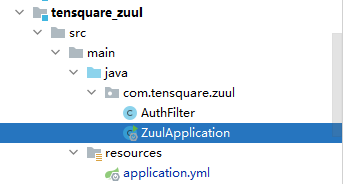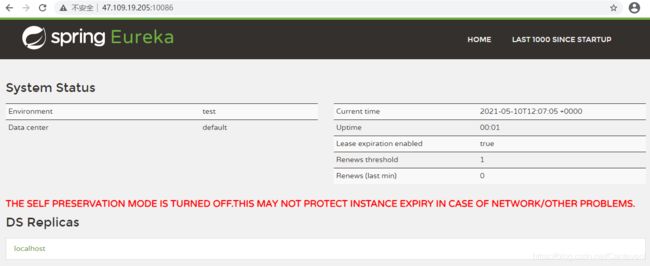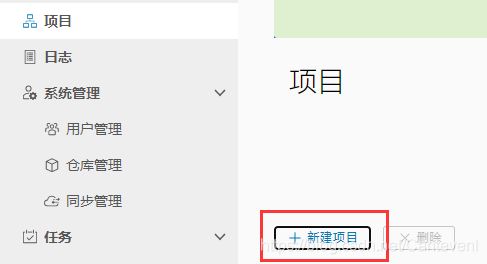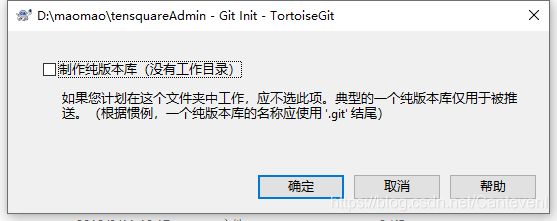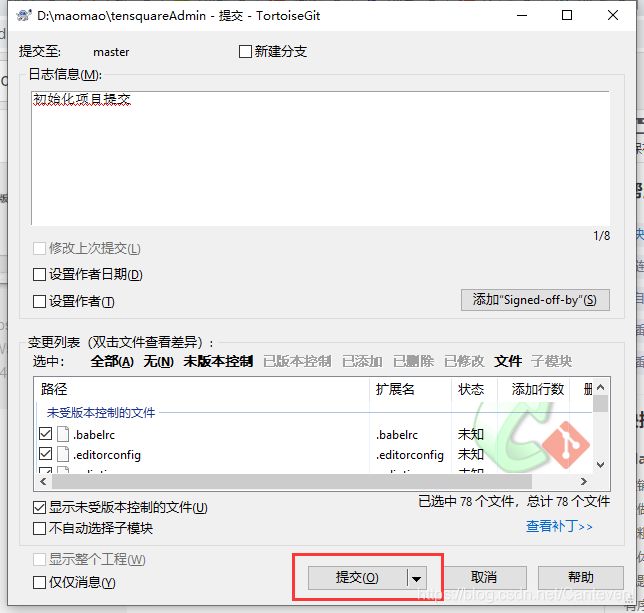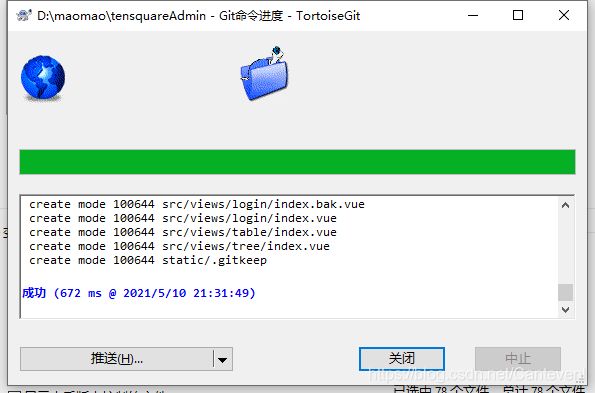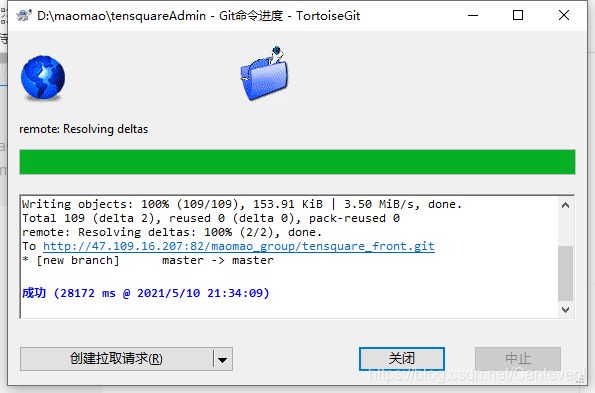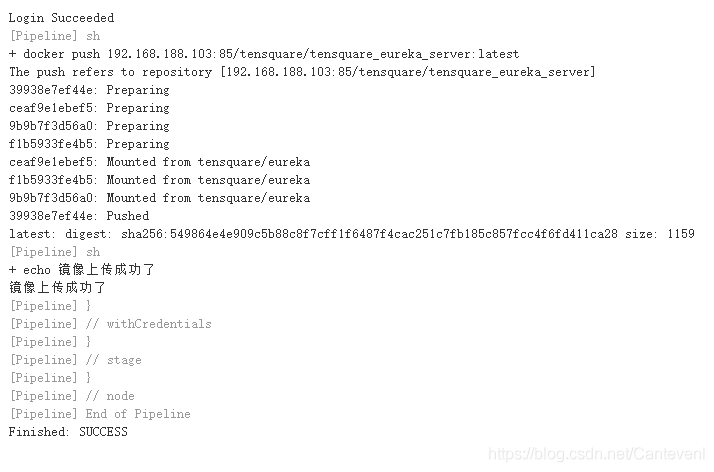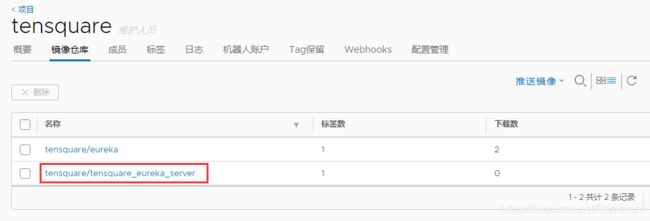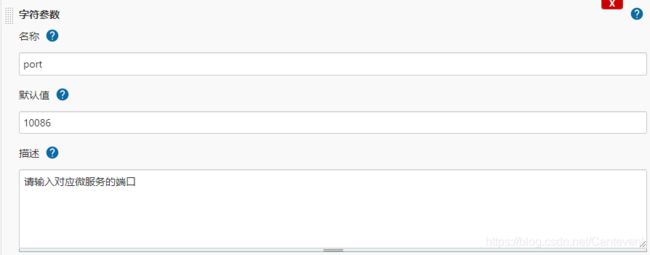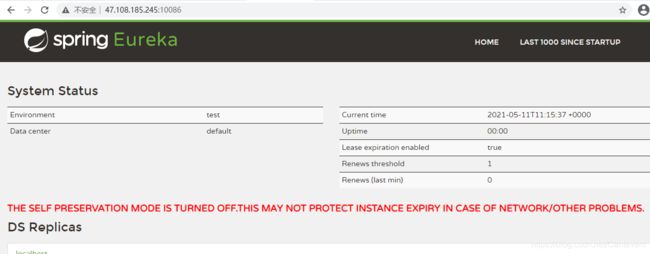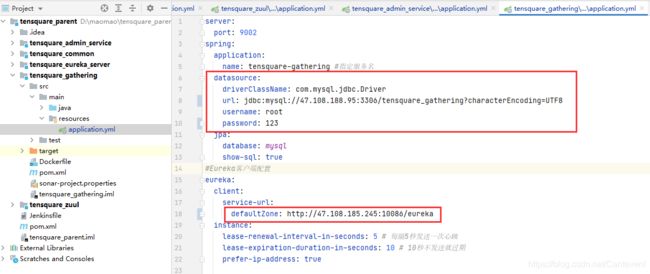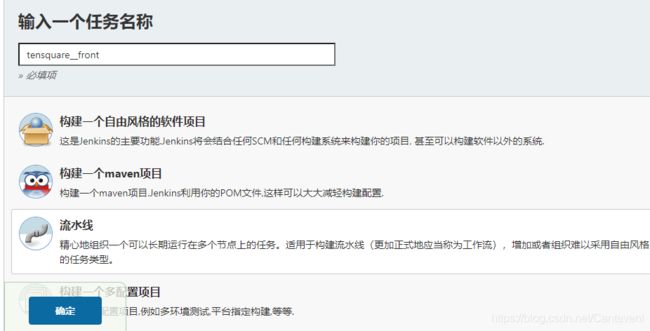Jenkins—— Jenkins+Docker+SpringCloud微服务持续集成
Jenkins+Docker+SpringCloud微服务持续集成
- Jenkins+Docker+SpringCloud持续集成流程说明
-
- SpringCloud微服务源码概述
- 本地部署
-
- SpringCloud微服务部署
- 使用Dockerfile制作微服务镜像
- Harbor镜像仓库安装及使用
-
- Harbor安装
- 在Harbor创建用户和项目
- 把镜像上传到Harbor
- 从Harbor下载镜像
- 微服务持续集成
-
- 项目代码上传到Gitlab
- 从Gitlab拉取项目源码
- 提交到SonarQube代码审查
- 将微服务打包成jar包
- 使用Dockerfile编译、生成镜像
- 上传到Harbor镜像仓库
-
- 报错
- 拉取镜像和发布应用
- 配置远程部署服务器
-
- 编写远程脚本文件
- 编写Jenkinsfile
- 更改微服务设置,准备好测试数据
- 部署前端静态web网站
Jenkins+Docker+SpringCloud持续集成流程说明
- 开发人员每天把代码提交到Gitlab代码仓库
- Jenkins从Gitlab中拉取项目源码,编译并打成jar包,然后构建成Docker镜像,将镜像上传到Harbor私有仓库
- Jenkins发送SSH远程命令,让生产部署服务器到Harbor私有仓库拉取镜像到本地,然后创建容器
- 最后,用户可以访问到容器
SpringCloud微服务源码概述
-
项目架构:前后端分离
-
后端技术栈:SpringBoot+SpringCloud+SpringDataJpa
-
- tensquare_parent:父工程,存放基础配置
- tensquare_common:通用工程,存放工具类
- tensquare_eureka_server:SpringCloud的Eureka注册中心
- tensquare_zuul:SpringCloud的网关服务
- tensquare_admin_service:基础权限认证中心,负责用户认证(使用JWT认证)
- tensquare_gathering:一个简单的业务模块,活动微服务相关逻辑
-
数据库结构:
- tensquare_user:用户认证数据库,存放用户账户数据。对应tensquare_admin_service微服务
- tensquare_gathering:活动微服务数据库。对应tensquare_gathering微服务
-
微服务配置分析:
- tensquare_eureka
- tensquare_zuul
- tensquare_admin_service
- tensquare_gathering
本地部署
逐一启动微服务
SpringCloud微服务部署
首先需要导入插件
在pom.xml里添加
![]()
<plugin>
<groupId>org.springframework.bootgroupId>
<artifactId>spring-boot-maven-pluginartifactId>
plugin>
使用Dockerfile制作微服务镜像
安装docker
安装需要的安装包
yum install -y yum-utils
设置镜像仓库
我们用阿里云
yum-config-manager \
--add-repo \
http://mirrors.aliyun.com/docker-ce/linux/centos/docker-ce.repo
更新yum软件包索引
yum makecache fast
安装docker docker-ce 社区
yum -y install docker-ce docker-ce-cli containerd.io
启动docker
systemctl start docker
查看版本
docker version
将eureka的jar包上传至服务器
mkdir /root/eureka
mv tensquare_eureka_server-1.0-SNAPSHOT.jar /root/eureka/
cd /root/eureka/
vim Dockerfile
FROM openjdk:8-jdk-alpine
ARG JAR_FILE
COPY ${JAR_FILE} app.jar
EXPOSE 10086
ENTRYPOINT ["java","-jar","/app.jar"]
docker build --build-arg JAR_FILE=tensquare_eureka_server-1.0-SNAPSHOT.jar -t eureka:v1
构建完成之后查看
[root@jenkins eureka]# docker images
REPOSITORY TAG IMAGE ID CREATED SIZE
eureka v1 255f6b6c7c53 4 seconds ago 150MB
openjdk 8-jdk-alpine a3562aa0b991 2 years ago 105MB
验证镜像是否成功
docker run -di -p 10086:10086 eureka:v1
查看日志
docker logs -f 容器id
Harbor镜像仓库安装及使用
- Harbor(港口,港湾)是一个用于存储和分发Docker镜像的企业级Registry服务器。
- 除了Harbor这个私有镜像仓库之外,还有Docker官方提供的Registry。相对Registry,Harbor具有很多优势:
- 提供分层传输机制,优化网络传输
Docker镜像是是分层的,而如果每次传输都使用全量文件(所以用FTP的方式并不适合),显然不经济。必须提供识别分层传输的机制,以层的UUID为标识,确定传输的对象。 - 提供WEB界面,优化用户体验
只用镜像的名字来进行上传下载显然很不方便,需要有一个用户界面可以支持登陆、搜索功能,包括区分公有、私有镜像。 - 支持水平扩展集群
当有用户对镜像的上传下载操作集中在某服务器,需要对相应的访问压力作分解。 - 良好的安全机制
企业中的开发团队有很多不同的职位,对于不同的职位人员,分配不同的权限,具有更好的安全性。
- 提供分层传输机制,优化网络传输
Harbor安装
我们在harbor服务器上进行安装
安装docker和compose
安装需要的安装包
yum install -y yum-utils
设置镜像仓库
我们用阿里云
yum-config-manager \
--add-repo \
http://mirrors.aliyun.com/docker-ce/linux/centos/docker-ce.repo
安装docker
yum install docker-ce docker-ce-cli containerd.io
systemctl enable docker --now
下载安装compose
curl -L https://get.daocloud.io/docker/compose/releases/download/1.25.5/docker-compose-$(uname -s)-$(uname -m) > /usr/local/bin/docker-compose
授权
chmod +x /usr/local/bin/docker-compose
查看版本
docker-compose version
安装harbor
下载地址
下载完毕之后上传至服务器
tar xf harbor-offline-installer-v1.9.2.tgz -C /usr/local
cd /usr/local/harbor
修改harbor.yml 文件里面的hostname 改成本机地址
vim harbor.yml
hostname: 192.168.188.103
端口改成85 就不会与80冲突
port: 85
拉取镜像命令
./prepare
安装
./install.sh
当完成安装后,即可通过本机地址进行浏览器的访问
在Harbor创建用户和项目
创建项目
Harbor的项目分为公开和私有的:
- 公开项目:所有用户都可以访问,通常存放公共的镜像,默认有一个library公开项目。
- 私有项目:只有授权用户才可以访问,通常存放项目本身的镜像。
我们可以为微服务项目创建一个新的项目
把镜像上传到Harbor
-
给镜像打上标签
[root@jenkins eureka]# docker images REPOSITORY TAG IMAGE ID CREATED SIZE eureka v1 255f6b6c7c53 32 minutes ago 150MB openjdk 8-jdk-alpine a3562aa0b991 2 years ago 105MB docker tag eureka:v1 192.168.188.103:85/tensquare/eureka:v1 [root@jenkins eureka]# docker images REPOSITORY TAG IMAGE ID CREATED SIZE 192.168.188.103:85/tensquare/eureka v1 255f6b6c7c53 33 minutes ago 150MB eureka v1 255f6b6c7c53 33 minutes ago 150MB openjdk 8-jdk-alpine a3562aa0b991 2 years ago 105MB -
把Harbor地址加入到Docker信任列表
vi /etc/docker/daemon.json { "registry-mirrors": ["https://zydiol88.mirror.aliyuncs.com"], "insecure-registries": ["192.168.188.103:85"] } 重启docker -
登录Harbor
docker login 192.168.188.103:85 -u maomao -p Xiaotian123 -
推送镜像
docker push 192.168.188.103:85/tensquare/eureka:v1
从Harbor下载镜像
在192.168.188.102服务器下载镜像
vi /etc/docker/daemon.json
{
"registry-mirrors": ["https://zydiol88.mirror.aliyuncs.com"],
"insecure-registries": ["192.168.188.103:85"]
}
systemctl daemon-reload
systemctl restart docker
先登录,再从Harbor下载镜像
[root@tomcat ~]# docker login 192.168.188.103:85 -u maomao -p Xiaotian123
WARNING! Using --password via the CLI is insecure. Use --password-stdin.
WARNING! Your password will be stored unencrypted in /root/.docker/config.json.
Configure a credential helper to remove this warning. See
https://docs.docker.com/engine/reference/commandline/login/#credentials-store
Login Succeeded
拉取镜像
docker pull 192.168.188.103:85/tensquare/eureka:v1
docker images
微服务持续集成
项目代码上传到Gitlab
上传后台微服务和前端web网站代码
首先去gitlab上面创建项目


我们在这个组里就有新建的两个项目

上传代码,通过IDEA操作
Add添加到本地缓冲区

将代码提交到本地代码仓库


新建一个仓库地址




推送代码至仓库

项目已经成功提交

前端代码我们通过Git小乌龟来上传
安装地址
从Gitlab拉取项目源码
选择SCM 脚本上传至仓库
配置git地址 通过ssh拉取

打开IDEA 在工程根目录下面创建一个Jenkinsfile
//git凭证ID
def git_auth = "41580d48-d4c3-4116-9a71-4d4d777c5753"
// git的url地址
def git_url = "[email protected]:maomao_group/tensquare_back.git"
node {
stage('拉取代码') {
checkout([$class: 'GitSCM', branches: [[name: "*/${branch}"]], extensions: [], userRemoteConfigs: [[credentialsId: "${git_auth}", url: "${git_url}"]]])
}
}
上传Jenkinsfile文件


开始构建项目



注意 脚本里面一定要注意格式和语法,自己因为冒号的原因,错了三次才改正过来
提交到SonarQube代码审查
在tensquare_back项目里,添加两个参数
这个参数选择选项参数(Choice Parameter)

添加需要选择审查的名字
![]()
这时候构建就可以选择需要审查的代码
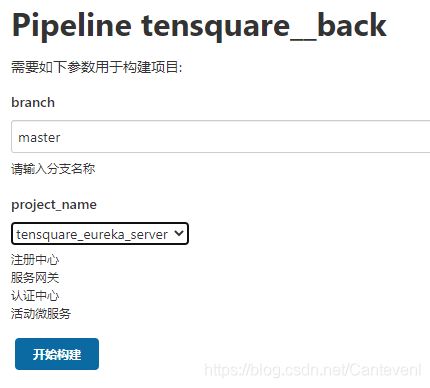
接下来配置sonarkube文件
在eureka_server根目录创建sonar-project.properties

eureka_server
# must be unique in a given SonarQube instance
sonar.projectKey=tensquare_eureka_server
# this is the name and version displayed in the SonarQube UI. Was mandatory prior to SonarQube 6.1.
sonar.projectName=tensquare_eureka_server
sonar.projectVersion=1.0
# Path is relative to the sonar-project.properties file. Replace "\" by "/" on Windows.
# This property is optional if sonar.modules is set.
sonar.sources=.
sonar.exclusions=**/test/**,**/target/**
sonar.java.binaries=.
sonar.java.source=1.8
sonar.java.target=1.8
#sonar.java.libraries=**/target/classes/**
# Encoding of the source code. Default is default system encoding
sonar.sourceEncoding=UTF-8
然后再相应的目录里添加不同的sonar-project.properties
zull
# must be unique in a given SonarQube instance
sonar.projectKey=tensquare_zuul
# this is the name and version displayed in the SonarQube UI. Was mandatory prior to SonarQube 6.1.
sonar.projectName=tensquare_zuul
sonar.projectVersion=1.0
# Path is relative to the sonar-project.properties file. Replace "\" by "/" on Windows.
# This property is optional if sonar.modules is set.
sonar.sources=.
sonar.exclusions=**/test/**,**/target/**
sonar.java.binaries=.
sonar.java.source=1.8
sonar.java.target=1.8
#sonar.java.libraries=**/target/classes/**
# Encoding of the source code. Default is default system encoding
sonar.sourceEncoding=UTF-8
admin_service
# must be unique in a given SonarQube instance
sonar.projectKey=tensquare_admin_service
# this is the name and version displayed in the SonarQube UI. Was mandatory prior to SonarQube 6.1.
sonar.projectName=tensquare_admin_service
sonar.projectVersion=1.0
# Path is relative to the sonar-project.properties file. Replace "\" by "/" on Windows.
# This property is optional if sonar.modules is set.
sonar.sources=.
sonar.exclusions=**/test/**,**/target/**
sonar.java.binaries=.
sonar.java.source=1.8
sonar.java.target=1.8
#sonar.java.libraries=**/target/classes/**
# Encoding of the source code. Default is default system encoding
sonar.sourceEncoding=UTF-8
gathering
# must be unique in a given SonarQube instance
sonar.projectKey=tensquare_gathering
# this is the name and version displayed in the SonarQube UI. Was mandatory prior to SonarQube 6.1.
sonar.projectName=tensquare_gathering
sonar.projectVersion=1.0
# Path is relative to the sonar-project.properties file. Replace "\" by "/" on Windows.
# This property is optional if sonar.modules is set.
sonar.sources=.
sonar.exclusions=**/test/**,**/target/**
sonar.java.binaries=.
sonar.java.source=1.8
sonar.java.target=1.8
#sonar.java.libraries=**/target/classes/**
# Encoding of the source code. Default is default system encoding
sonar.sourceEncoding=UTF-8
修改Jenkinsfile脚本
//git凭证ID
def git_auth = "41580d48-d4c3-4116-9a71-4d4d777c5753"
// git的url地址
def git_url = "[email protected]:maomao_group/tensquare_back.git"
node {
stage('拉取代码') {
checkout([$class: 'GitSCM', branches: [[name: "*/${branch}"]], extensions: [], userRemoteConfigs: [[credentialsId: "${git_auth}", url: "${git_url}"]]])
}
stage('代码审查') {
//定义了当前Jenkins的SonarQubeScanner工具环境 在全局工具配置里查看
def scannerHome = tool 'sonar-scanner'
//引用当前JenkinsSonarQube环境 在系统配置里查看
withSonarQubeEnv('sonarqube') {
sh """
cd ${project_name}
${scannerHome}/bin/sonar-scanner
"""
}
}
}
开始审查代码

构建成功

来到sonarkube后台查看审查结果
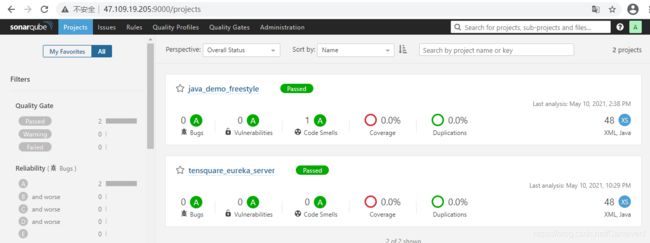
然后我们把剩下三个代码也进行审查

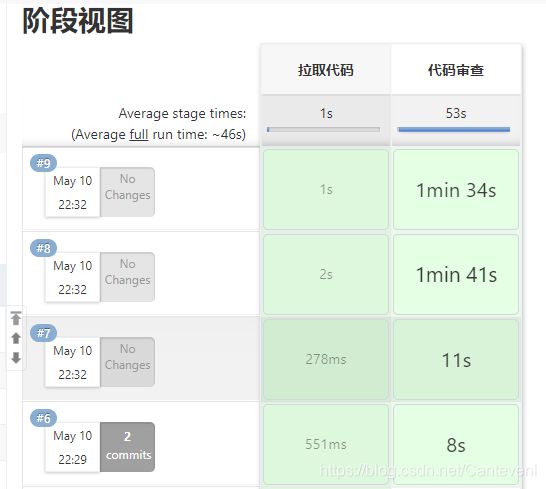
没有问题

将微服务打包成jar包
第一步 需要对一个公共的子工程进程编译,安装
在Jenkinsfile里添加一个步骤
//git凭证ID
def git_auth = "41580d48-d4c3-4116-9a71-4d4d777c5753"
// git的url地址
def git_url = "[email protected]:maomao_group/tensquare_back.git"
node {
stage('拉取代码') {
checkout([$class: 'GitSCM', branches: [[name: "*/${branch}"]], extensions: [], userRemoteConfigs: [[credentialsId: "${git_auth}", url: "${git_url}"]]])
}
stage('代码审查') {
//定义了当前Jenkins的SonarQubeScanner工具环境 在全局工具配置里查看
def scannerHome = tool 'sonar-scanner'
//引用当前JenkinsSonarQube环境 在系统配置里查看
withSonarQubeEnv('sonarqube') {
sh """
cd ${project_name}
${scannerHome}/bin/sonar-scanner
"""
}
}
stage('编译,安装公共子工程') {
sh "mvn -f tensquare_common clean install"
}
}
将脚本上传至git仓库,再尝试进行一次构建


进行打包

构建成功


如果失败的话,进入IDEA
将tensquare_parent父工程里面的 spring-boot-maven插件移走 移到需要项目打包的项目里去
tensquare_common子工程不需要这个插件
只需要将插件加入tensquare_eureka_server、tensquare_admin_service、tensquare_gathering、tensquare_zuul
<build>
<plugins>
<plugin>
<groupId>org.springframework.bootgroupId>
<artifactId>spring-boot-maven-pluginartifactId>
plugin>
plugins>
build>
调整好之后,继续编写Jenkinsfile,需要打包其他微服务了
//git凭证ID
def git_auth = "41580d48-d4c3-4116-9a71-4d4d777c5753"
// git的url地址
def git_url = "[email protected]:maomao_group/tensquare_back.git"
node {
stage('拉取代码') {
checkout([$class: 'GitSCM', branches: [[name: "*/${branch}"]], extensions: [], userRemoteConfigs: [[credentialsId: "${git_auth}", url: "${git_url}"]]])
}
stage('代码审查') {
//定义了当前Jenkins的SonarQubeScanner工具环境 在全局工具配置里查看
def scannerHome = tool 'sonar-scanner'
//引用当前JenkinsSonarQube环境 在系统配置里查看
withSonarQubeEnv('sonarqube') {
sh """
cd ${project_name}
${scannerHome}/bin/sonar-scanner
"""
}
}
stage('编译,安装公共子工程') {
sh "mvn -f tensquare_common clean install"
}
// 这里project_name就是参数 选择对谁打包
stage('编译,安装公共子工程') {
sh "mvn -f ${project_name} clean package"
}
}
对eureka服务进行打包


通过目录也可以看见 tensquare_admin_service没有进行打包
tensquare_eureka_server进行了打包 target下有jar包

接下来将其它三个微服务以同样方式打包
但是在打包tensquare_zuul报错了

因为网关依赖父工程,但是仓库里的父工程没有
因此我们需要手动将父工程pom.xml文件传到Jenkins服务器里

再次重新构建
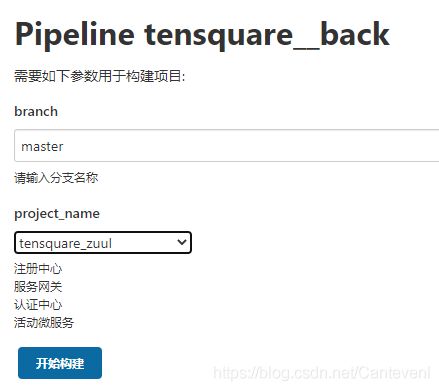
这次找到父工程的pom文件之后 打包成功

然后将剩下两个微服务打包构建

除了第二次打包网关失败 其余都成功了
使用Dockerfile编译、生成镜像
利用dockerfile-maven-plugin插件构建Docker镜像
在每个微服务项目的pom.xml加入dockerfile-maven-plugin插件
我们可以在之前spring-boot-maven-plugin插件下面添加dockerfile-maven-plugin插件
<build>
<plugins>
<plugin>
<groupId>org.springframework.bootgroupId>
<artifactId>spring-boot-maven-pluginartifactId>
plugin>
<plugin>
<groupId>com.spotifygroupId>
<artifactId>dockerfile-maven-pluginartifactId>
<version>1.3.6version>
<configuration>
<repository>${project.artifactId}repository>
<buildArgs>
<JAR_FILE>target/${project.build.finalName}.jarJAR_FILE>
buildArgs>
configuration>
plugin>
plugins>
build>
在每个微服务里创建一个Dockerfile文件
![]()
#FROM java:8
FROM openjdk:8-jdk-alpine
ARG JAR_FILE
COPY ${JAR_FILE} app.jar
EXPOSE 10086
ENTRYPOINT ["java","-jar","/app.jar"]
修改Jenkinsfile 添加dockerfile:build命令
//git凭证ID
def git_auth = "41580d48-d4c3-4116-9a71-4d4d777c5753"
// git的url地址
def git_url = "[email protected]:maomao_group/tensquare_back.git"
node {
stage('拉取代码') {
checkout([$class: 'GitSCM', branches: [[name: "*/${branch}"]], extensions: [], userRemoteConfigs: [[credentialsId: "${git_auth}", url: "${git_url}"]]])
}
stage('代码审查') {
//定义了当前Jenkins的SonarQubeScanner工具环境 在全局工具配置里查看
def scannerHome = tool 'sonar-scanner'
//引用当前JenkinsSonarQube环境 在系统配置里查看
withSonarQubeEnv('sonarqube') {
sh """
cd ${project_name}
${scannerHome}/bin/sonar-scanner
"""
}
}
stage('编译,安装公共子工程') {
sh "mvn -f tensquare_common clean install"
}
stage('编译,安装公共子工程') {
sh "mvn -f ${project_name} clean package dockerfile:build"
}
}
然后对eureka_server进行构建

进行镜像的制作

执行Dockerfile里写的步骤

最后成功

查看镜像,已经创建成功

接下来把其他微服务也构建成镜像,需要写Dockerfile和添加插件
tensquare_zuul
#FROM java:8
FROM openjdk:8-jdk-alpine
ARG JAR_FILE
COPY ${JAR_FILE} app.jar
EXPOSE 10020
ENTRYPOINT ["java","-jar","/app.jar"]
tensquare_admin_service
#FROM java:8
FROM openjdk:8-jdk-alpine
ARG JAR_FILE
COPY ${JAR_FILE} app.jar
EXPOSE 9001
ENTRYPOINT ["java","-jar","/app.jar"]
tensquare_gathering
#FROM java:8
FROM openjdk:8-jdk-alpine
ARG JAR_FILE
COPY ${JAR_FILE} app.jar
EXPOSE 9002
ENTRYPOINT ["java","-jar","/app.jar"]
上传代码之后进行构建
上传到Harbor镜像仓库
修改Jenkinsfile构建脚本
//git凭证ID
def git_auth = "41580d48-d4c3-4116-9a71-4d4d777c5753"
// git的url地址
def git_url = "[email protected]:maomao_group/tensquare_back.git"
// 镜像的版本号
def tag = "latest"
// Harbor的url地址
def harbor_url = "192.168.188.103:85"
// 镜像库项目名称
def harbor_project = "tensquare"
node {
stage('拉取代码') {
checkout([$class: 'GitSCM', branches: [[name: "*/${branch}"]], extensions: [], userRemoteConfigs: [[credentialsId: "${git_auth}", url: "${git_url}"]]])
}
stage('代码审查') {
//定义了当前Jenkins的SonarQubeScanner工具环境 在全局工具配置里查看
def scannerHome = tool 'sonar-scanner'
//引用当前JenkinsSonarQube环境 在系统配置里查看
withSonarQubeEnv('sonarqube') {
sh """
cd ${project_name}
${scannerHome}/bin/sonar-scanner
"""
}
}
stage('编译,安装公共子工程') {
sh "mvn -f tensquare_common clean install"
}
stage('编译,安装公共子工程,上传镜像') {
sh "mvn -f ${project_name} clean package dockerfile:build"
//定义镜像名称
def imageName = "${project_name}:${tag}"
//对镜像打上标签
sh "docker tag ${imageName} ${harbor_url}/${harbor_project}/${imageName}"
}
}
添加一个harbor用户凭据
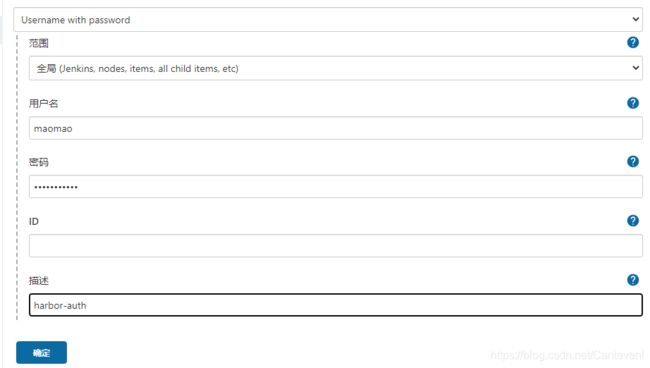
再次进去查看 将生成的id复制

4135b3f5-a3eb-436e-a6ef-fe096098bb4f
// git凭证ID
def git_auth = "41580d48-d4c3-4116-9a71-4d4d777c5753"
// git的url地址
def git_url = "[email protected]:maomao_group/tensquare_back.git"
// 镜像的版本号
def tag = "latest"
// Harbor的url地址
def harbor_url = "192.168.188.103:85"
// 镜像库项目名称
def harbor_project = "tensquare"
// Harbor的登录凭据ID
def harbor_auth = "4135b3f5-a3eb-436e-a6ef-fe096098bb4f"
node {
stage('拉取代码') {
checkout([$class: 'GitSCM', branches: [[name: "*/${branch}"]], extensions: [], userRemoteConfigs: [[credentialsId: "${git_auth}", url: "${git_url}"]]])
}
stage('代码审查') {
//定义了当前Jenkins的SonarQubeScanner工具环境 在全局工具配置里查看
def scannerHome = tool 'sonar-scanner'
//引用当前JenkinsSonarQube环境 在系统配置里查看
withSonarQubeEnv('sonarqube') {
sh """
cd ${project_name}
${scannerHome}/bin/sonar-scanner
"""
}
}
stage('编译,安装公共子工程') {
sh "mvn -f tensquare_common clean install"
}
stage('编译,安装公共子工程,上传镜像') {
sh "mvn -f ${project_name} clean package dockerfile:build"
//定义镜像名称
def imageName = "${project_name}:${tag}"
//对镜像打上标签
sh "docker tag ${imageName} ${harbor_url}/${harbor_project}/${imageName}"
//把镜像推送到Harbor
withCredentials([usernamePassword(credentialsId: "${harbor_auth}", passwordVariable: 'password', usernameVariable: 'username')]) {
// 登录到Harbor
sh "docker login -u ${username} -p ${password} ${harbor_url}"
// 镜像上传
sh "docker push ${harbor_url}/${harbor_project}/${imageName}"
sh "echo 镜像上传成功了"
}
}
}
报错
这一步有两个小细节错了 害得我弄了一个多小时才找出来,气得要死

这里显示我docker tag 命令参数多了
后面仔细检测发现这里多了一个空格

各种排查,仍然有空格,后面在任务配置里找到选项参数

发现这里面的选项前面打了空格,导致脚本读取参数也包含了空格
拉取镜像和发布应用
安装Publish Over SSH插件 可以实现远程发送Shell命令

配置远程部署服务器
将jenkins服务器的公钥拷贝到远程tomcat服务器
ssh-copy-id 192.168.188.107
在jenkins进入系统配置,找到Publish over SSH
Path to key 填私钥存放的位置 /root/.ssh/id_rsa

下面点击新增
Hostname 填 远程部署项目的主机ip

接下来要写Jenkinsfile脚本,首先去流水线语法
找到这个 可以帮我们产生一些远程连接的脚本
![]()
ssh server 选择我们之前传公钥的服务器
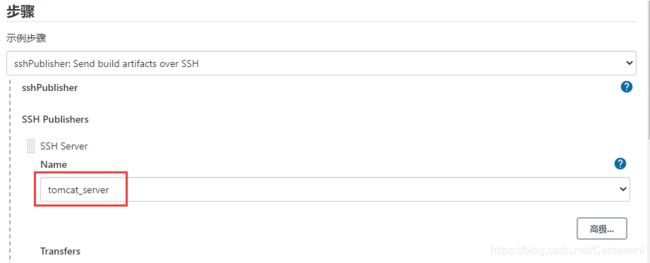
其他现在都留空,点击生成流水线脚本

这段就是复制下来的脚本
sshPublisher(publishers: [sshPublisherDesc(configName: 'tomcat_server', transfers: [sshTransfer(cleanRemote: false, excludes: '', execCommand: '', execTimeout: 120000, flatten: false, makeEmptyDirs: false, noDefaultExcludes: false, patternSeparator: '[, ]+', remoteDirectory: '', remoteDirectorySDF: false, removePrefix: '', sourceFiles: '')], usePromotionTimestamp: false, useWorkspaceInPromotion: false, verbose: false)])
编写远程脚本文件
进入tomcat服务器
[root@tomcat ~]# mkdir /opt/jenkins_shell
[root@tomcat ~]# cd /opt/jenkins_shell/
[root@tomcat jenkins_shell]# vim deploy.sh
#! /bin/bash
#接收外部参数
harbor_url=$1
harbor_project=$2
project_name=$3
tag=$4
port=$5
imageName=$harbor_url/$harbor_project/$project_name:$tag
echo "$imageName"
#查询容器是否存在,存在则删除
containerId=`docker ps -a | grep -w ${
project_name}:${
tag} | awk '{print $1}'`
if [ "$containerId" != "" ] ; then
#停掉容器
docker stop $containerId
#删除容器
docker rm $containerId
echo "成功删除容器"
fi
#查询镜像是否存在,存在则删除
imageId=`docker images | grep -w $project_name | awk '{print $3}'`
if [ "$imageId" != "" ] ; then
#删除镜像
docker rmi -f $imageId
echo "成功删除镜像"
fi
# 登录Harbor
docker login -u maomao -p Xiaotian123 $harbor_url
# 下载镜像
docker pull $imageName
# 启动容器
docker run -di -p $port:$port $imageName
echo "容器启动成功"
然后给脚本加上执行权限
chmod +x deploy.sh
编写Jenkinsfile
// git凭证ID
def git_auth = "41580d48-d4c3-4116-9a71-4d4d777c5753"
// git的url地址
def git_url = "[email protected]:maomao_group/tensquare_back.git"
// 镜像的版本号
def tag = "latest"
// Harbor的url地址
def harbor_url = "192.168.188.106:85"
// 镜像库项目名称
def harbor_project = "tensquare"
// Harbor的登录凭据ID
def harbor_auth = "c0e6642d-bab9-4978-be45-955e5130fae2"
node {
stage('拉取代码') {
checkout([$class: 'GitSCM', branches: [[name: "*/${branch}"]], extensions: [], userRemoteConfigs: [[credentialsId: "${git_auth}", url: "${git_url}"]]])
}
stage('代码审查') {
//定义了当前Jenkins的SonarQubeScanner工具环境 在全局工具配置里查看
def scannerHome = tool 'sonar-scanner'
//引用当前JenkinsSonarQube环境 在系统配置里查看
withSonarQubeEnv('sonarqube') {
sh """
cd ${project_name}
${scannerHome}/bin/sonar-scanner
"""
}
}
stage('编译,安装公共子工程') {
sh "mvn -f tensquare_common clean install"
}
stage('编译,安装公共子工程,上传镜像') {
sh "mvn -f ${project_name} clean package dockerfile:build"
//定义镜像名称
def imageName = "${project_name}:${tag}"
//对镜像打上标签
sh "docker tag ${imageName} ${harbor_url}/${harbor_project}/${imageName}"
//把镜像推送到Harbor
withCredentials([usernamePassword(credentialsId: "${harbor_auth}", passwordVariable: 'password', usernameVariable: 'username')]) {
// 登录到Harbor
sh "docker login -u ${username} -p ${password} ${harbor_url}"
// 镜像上传
sh "docker push ${harbor_url}/${harbor_project}/${imageName}"
sh "echo 镜像上传成功啦"
}
// 部署项目
sshPublisher(publishers: [sshPublisherDesc(configName: 'tomcat_server', transfers: [sshTransfer(cleanRemote: false, excludes: '', execCommand: "/opt/jenkins_shell/deploy.sh $harbor_url $harbor_project $project_name $tag $port", execTimeout: 120000, flatten: false, makeEmptyDirs: false, noDefaultExcludes: false, patternSeparator: '[, ]+', remoteDirectory: '', remoteDirectorySDF: false, removePrefix: '', sourceFiles: '')], usePromotionTimestamp: false, useWorkspaceInPromotion: false, verbose: false)])
}
}
上传代码之后构建项目
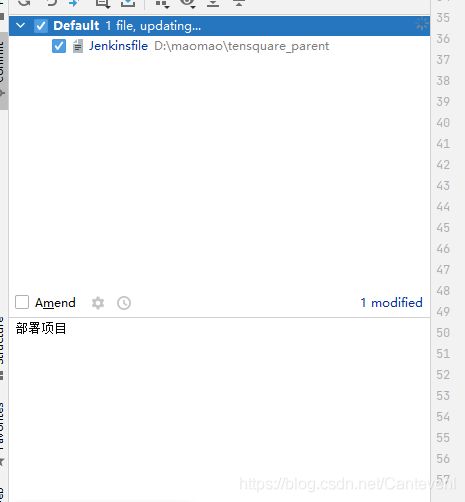
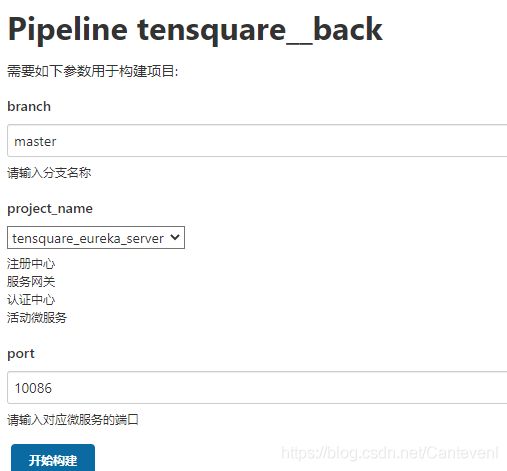
开始远程登录服务器执行脚本

在部署服务器上查看镜像和容器

更改微服务设置,准备好测试数据
- eureka配置
修改ip地址为我们部署的服务器地址

- zuul网关
也是修改eruka的ip地址

- admin_service权限中心
这里需要修改数据库相关信息(我们选择sonarqube服务器上的mysql作为后端数据库,此数据库在jenkins服务器上) - 因此我们需要去mysql里面进行授权
授权root账户能够在所以客户端登录
grant all privileges on *.* to 'root'@'%' identified by '123';
刷新权限
flush privileges;
最后将所有更新的配置上传代码仓库
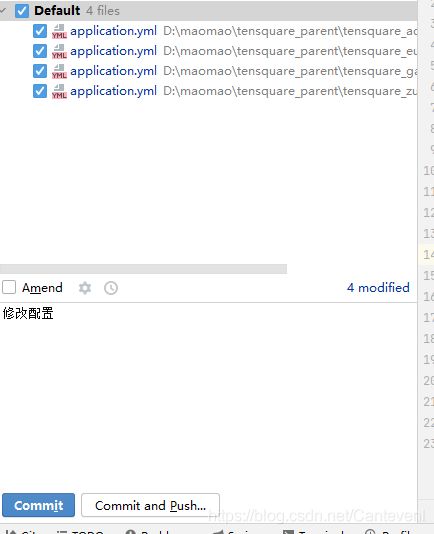
然后导入mysql数据
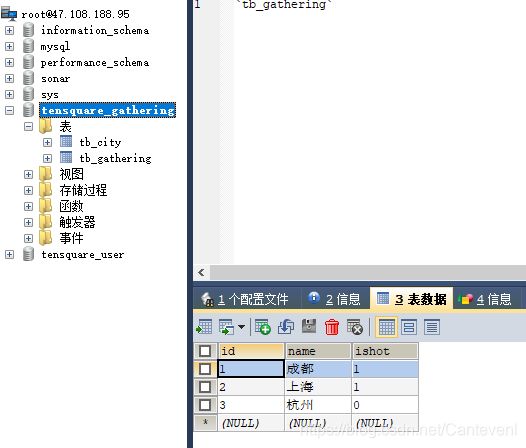
最后把剩下的三个微服务也构建成容器
这里需要注意的是要改变端口
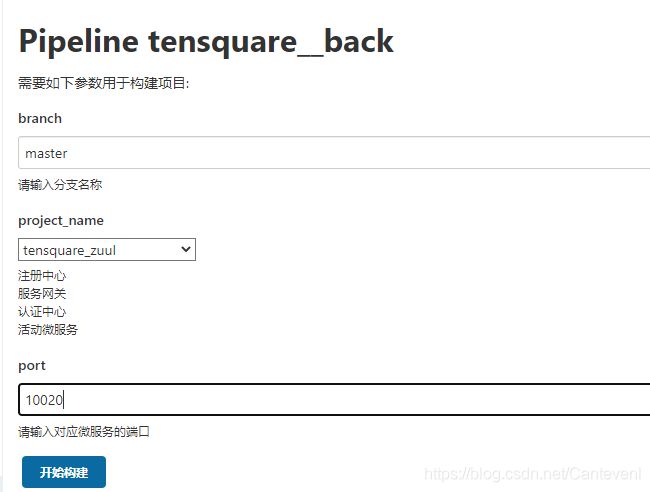

查看容器

通过浏览器查看
部署前端静态web网站
在tomcat服务器上进行
yum install -y epel-release
yum -y install nginx
修改nginx的端口,默认80,改为9090
vim /etc/nginx/nginx.conf
server {
listen 9090 default_server;
listen [::]:9090 default_server;
server_name _;
root /usr/share/nginx/html;
启动nginx
systemctl enable nginx --now

安装NodeJS插件

Jenkins在全局工具配置里配置Nginx服务器
编写流水线脚本
//gitlab的凭证
def git_auth = "41580d48-d4c3-4116-9a71-4d4d777c5753"
node {
stage('拉取代码') {
checkout([$class: 'GitSCM', branches: [[name: '*/${branch}']],
doGenerateSubmoduleConfigurations: false, extensions: [], submoduleCfg: [],
userRemoteConfigs: [[credentialsId: "${git_auth}", url:
'[email protected]:maomao_group/tensquare_front.git']]])
}
stage('打包,部署网站') {
//使用NodeJS的npm进行打包
nodejs('nodejs12'){
sh '''
npm install
npm run build
'''
}
//=====以下为远程调用进行项目部署========
sshPublisher(publishers: [sshPublisherDesc(configName: 'tomcat_server',
transfers: [sshTransfer(cleanRemote: false, excludes: '', execCommand: '',
execTimeout: 120000, flatten: false, makeEmptyDirs: false, noDefaultExcludes:
false, patternSeparator: '[, ]+', remoteDirectory: '/usr/share/nginx/html',
remoteDirectorySDF: false, removePrefix: 'dist', sourceFiles: 'dist/**')],
usePromotionTimestamp: false, useWorkspaceInPromotion: false, verbose: false)])
}
}
注意里面的git_auth 凭据id需要去jenkins里面找


构建成功

通过浏览器登录ip+9090端口
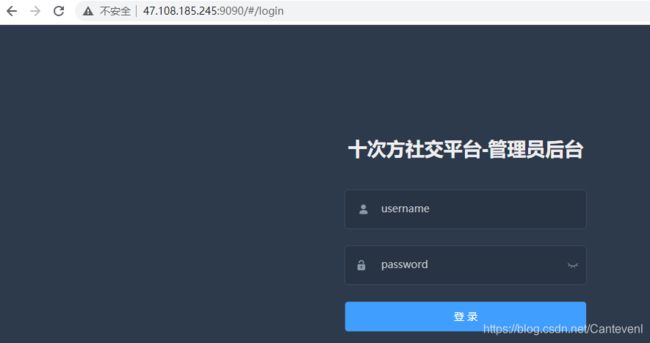
登录
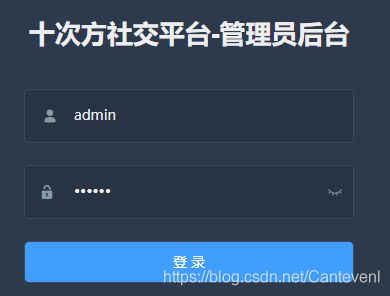
查询到了数据库的信息,因此证明前端页面和后端连接成功






